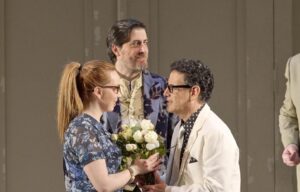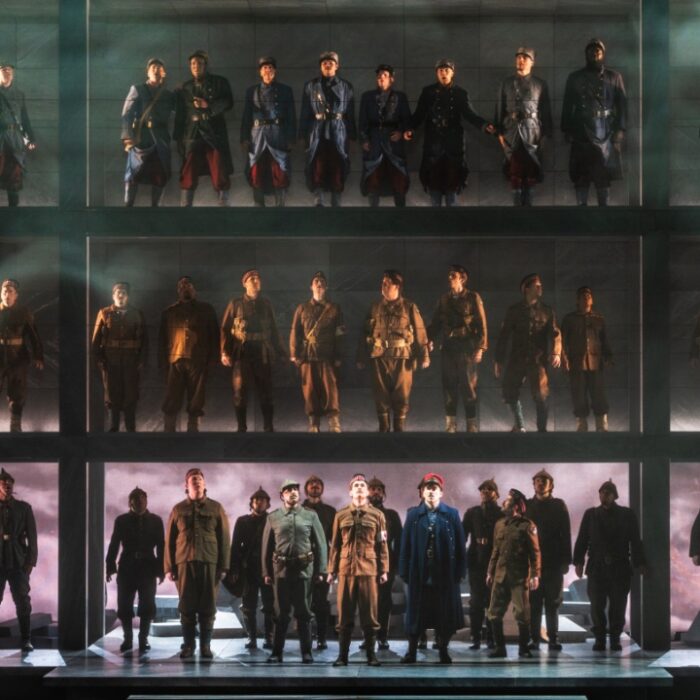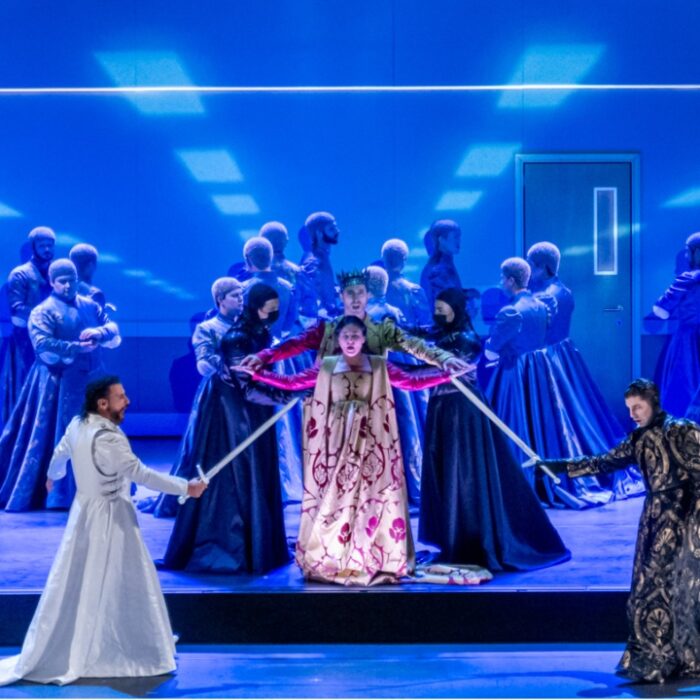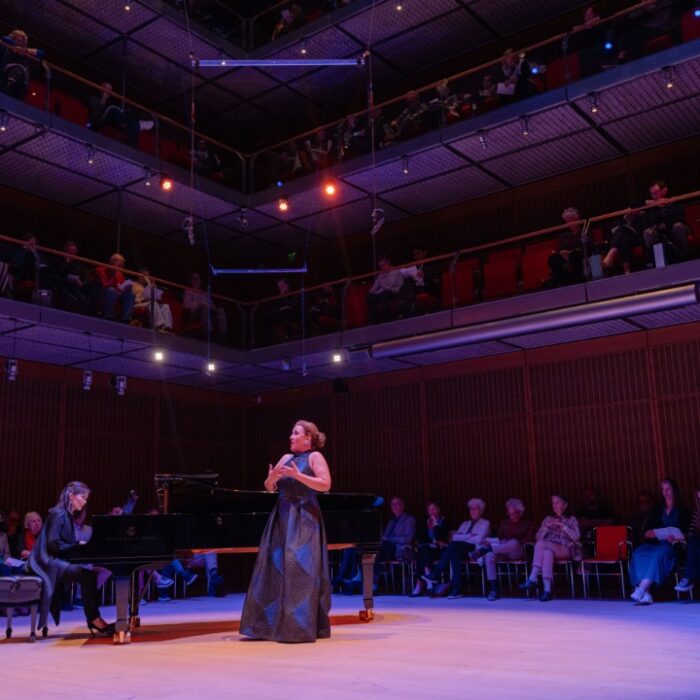
Wiener Staatsoper 2023-24 Review: La Cenerentola
By Laura Servidei(Photo © Wiener Staatsoper / Michael Pöhn)
“La Cenerentola” premiered in 1817, shortly after Rossini’s success with “Il Barbiere di Siviglia.” History tells us that it was composed in just three weeks, with only minimal self-plagiarism: the overture was borrowed from “La Gazetta,” and the protagonist’s final rondo from the tenor’s final aria in “Il Barbiere.” The story is a reimagining of one of the most famous fairy tales in the Western world: Cinderella. The modifications to the plot (see this article) likely contributed to the opera’s enduring success over time.
San Sogno: A Dream of Italy in the Fifties
The Wiener Staatsoper revives a production by Sven-Eric Bechtolf from 2013, where the action is moved to the fictional realm of “San Sogno,” a re-imagining of Italy in the 1950s, filled with period fancy cars, clothing (costumes by Marianne Glittenberg), Italian gasoline and beverage brands of that era. The sets by Rolf Glittenberg represent Don Magnifico’s dilapidated palace as a flat wooden-paneled backdrop, on which five doors open, representing at times the evil step-sisters’ overflowing wardrobes, or Don Magnifico’s vertical bed, or the kitchen. In the beginning we see debt collectors taking away the last paintings, carpets, and other valuable items, to underline Magnifico’s true reason for desiring a royal wedding for one of his daughters.
When Alidoro, the Prince’s tutor and fairy-godmother figure, invites Cinderella to the ball, it’s because he’s convinced of her good heart and virtues, hoping to nurture their budding love. In this rendition, Cinderella selects her ball gown from a lineup of models, each emerging from one of five doors, each dressed identically but in varying colors, in classic Disney style. The prince’s palace is portrayed as a garage adorned with gleaming vintage cars, with a balcony extending from the back of the stage. While the production is entertaining, it lacks a certain charm. The comedic elements feel somewhat cheap, with some bulky male chorus members dressed as secretaries taking dictation for Don Magnifico, and Cinderella using the same brush for her hair as she does for scrubbing the floor. While not overly dramatic, the performance falls short in capturing that enchanting quality.
Angelina (Cinderella) is recognized as one of the most demanding roles in the Rossini repertoire; Vasilisa Berzhanskaya proved herself more than capable for the challenge. She tackled the intricate passages with fearless confidence, her coloratura precise and crisp, every note perfectly in tune. Her high notes soared brilliantly, displaying no hint of strain. Yet, the foundation of her voice lies firmly in the middle register, imbuing it with a warm, bronzed hue that exudes a sense of heroism.
In moments where she delved into the lower register, she managed to produce a rounded, elegant sound, although occasionally showing signs of effort. Given the epic, almost warrior-like quality of her vocal delivery, she excelled in the rapid-fire coloratura runs, such as in “Non più mesta,” where her performance was particularly successful. However, in the more lyrical passages, like “Ah signor, s’è ver che in petto,” while showcasing a strong legato supported by a remarkable breath control, she perhaps lacked a certain emotive quality, missing some of Angelina’s inherent sweetness and kindness. On the other hand, her Cinderella had a fierce determination, bravely standing up against her wicked stepfather and stepsisters, confronting them with unwavering courage.
Tenors Playing Musical Chairs
The tenor role in this production became a hot topic among opera fans. Rossini superstar Juan Diego Flórez was initially scheduled for “Guillaume Tell,” on stage at the Wiener Staatsoper during this period, but had to cancel due to tracheitis. His replacement was another Rossini renowned tenor, John Osborn. However, when Edgardo Rocha, another prominent Rossini tenor, fell ill and had to cancel the three performances of “La Cenerentola,” guess who stepped in? Juan Diego Flórez himself. This tenor merry-go-round caused quite a stir among fans, leading to wild conspiracy theories. Some were puzzled by Flórez falling ill for one opera but miraculously recovering for another, all while Osborn seemingly had no prior commitments right in the middle of all the seasons. We absolutely believe the explanations provided by the individuals involved and the Wiener Staatsoper, but still, the situation elicited a lot of attention.
Nevertheless, we were fortunate to have the opportunity to hear Juan Diego Flórez in the role of Prince Ramiro, a part he had more or less officially stepped away from, and it was truly delightful. His high notes still shone like laser beams, treating us to not just one but TWO high Ds in his aria “Sì, ritrovarla io giuro”! His coloratura was magnificent, but what truly distinguished his performance, as always, was his natural elegance and innate musicality, which effortlessly infused every phrase.
Despite his evident caution, compared to previous years when tackling the most challenging passages, Flórez’s affinity for Rossini’s music remains unparalleled. The duet in Act one between him and Berzhanskaya was simply heart-melting.
More Cast Highlights
Dandini, Prince Ramiro’s valet who spends most of the opera disguised as the prince himself, was portrayed by Michael Arivony, a young singer recently emerged from the Wiener Staatsoper studio, whose career shows promise. He skillfully embodied the role of the buffo-baritone, delivering an entertaining comedic performance with impeccable timing. Arivony’s smooth baritone exhibited strength in the lower register, crucial for this role, as demonstrated in the first aria “Come un’ape” while his high notes remained well-supported and secure. His execution of coloratura passages was flawless.
Misha Kiria took on the role of Don Magnifico, the villainous stepfather, with a commanding, well-projected bass. While his interpretation may not have been entirely in the Rossinian vein, he effectively portrayed the character with distinctiveness. Kiria succeeded admirably in his three arias, capturing the essence of the role.
Roberto Tagliavini took on the role of Alidoro, the “fairy godmother” character, and delivered a remarkable performance in the truly challenging aria “Là, del ciel”, written by Rossini for Gioacchino Moncada, an exceptionally good bass singing in a revival in 1820. However, the director’s decision to portray Alidoro as comic relief, in an opera that inherently lacks such need, proved unfortunate. Despite this, Tagliavini approached the role with grace, incorporating comedic elements such as hearty laughter, suggestive gestures towards young beautiful women, and even improvising a small skit in front of the closed curtain during a scene change.
The orchestra, a selection from the Wiener Staatsoper orchestra, was under the baton of Gianluca Capuano, a seasoned expert in this repertoire. However, the performance encountered various issues, ranging from a shaky start with the uncertain attack on the first chord of the overture to occasional imprecisions in the horn section. Capuano’s tempos tended to be brisk overall; while the particularly challenging sections, such as the various concertati, were executed with precision, in other parts, Capuano seemed to struggle to establish and maintain the correct tempo. The overall impression conveyed was one of insufficient rehearsal time rather than any fundamental shortcomings. The booing from a very small fraction of the audience directed towards the conductor appeared to be unwarranted and inappropriate.



